Many discerning homeowners believe that crafting a genuinely restorative and cozy living room sanctuary requires architectural changes or a complete furniture overhaul. Consequently, they often endure spaces that feel sterile and uninviting. In these rooms, harsh overhead lighting and visual clutter amplify the day’s stress, preventing the mind from switching off and denying you that crucial feeling of relief upon walking through the door.
Creating a “warm embrace” actually relies on adaptable, sensory-based styling techniques rather than renovation. The transition from cold to cozy begins with mastering the three-layer lighting rule, swapping cool bulbs for soft 2700K LEDs to mimic the glow of a fire. It involves layering “pet-able” textures and prioritizing visual rest by concealing clutter.
These intentional adjustments trigger a psychological response, instantly signaling the body to relax and let go of exterior tension. This guide outlines essential strategies to design your own “Exhale Moment.” We will explore how to select grounding earthy palettes, engage the sense of smell with subtle notes of vanilla or sandalwood, and strategically style your space to turn a cold house into a restorative retreat.
1. The Foundation: Grounding the Space with High-Pile Area Rugs
A cohesive living room starts from the ground up. To anchor your design, select a high-pile rug large enough to accommodate at least the front two legs of your sofa and accent chairs. This visual alignment connects your furniture, making the seating arrangement feel defined and intentional.
Beyond aesthetics, the density of plush rugs acts as a powerful thermal insulator and sound dampener. By reducing echo and retaining heat, you establish a tranquil environment essential for a truly cozy gathering space.

Material selection plays a crucial role in comfort and longevity. Choose wool for natural insulation and durability, or opt for shag and faux fur to deliver sink-in softness that transforms cold flooring into an inviting zone. However, high-pile textures require strategic placement due to cleaning requirements.
Position these rugs specifically in the main conversation area where feet rest, rather than in busy pathways. This approach preserves the plush pile and simplifies maintenance by keeping the rug away from heavy foot traffic.
For a custom look that adds significant depth, consider layering your textiles. Place a smaller, high-pile rug, such as a Moroccan shag or faux sheepskin, on top of a larger, neutral low-pile foundation like jute or a flatweave. This technique doubles the visual warmth and allows you to introduce trending textures without committing to a large-scale investment. Layering provides the flexibility to easily update the room’s style, creating an adaptable space that evolves with the seasons.
2. Lighting Temperature: Why 2700K is the Gold Standard for Cozy
To create a truly inviting living room, the color temperature of your light bulbs matters just as much as the fixtures themselves. 2700K, often labeled as “Soft White,” emits a warm, yellowish-white glow that mimics the intimate feeling of traditional incandescent bulbs or a setting sun.
This specific temperature serves as the gold standard for relaxation because it softens harsh shadows and minimizes clinical lines. It also acts as a natural filter for your interior design; the warm light enhances rich wood finishes, woven textiles, and paint colors, instantly making the space feel grounded and comfortable.

Achieving a cozy atmosphere requires the right distribution of this light. Do not rely on a single overhead fixture, which often flattens the room’s appearance. Instead, install 2700K bulbs across multiple layers, such as table lamps, floor lamps, and wall sconces. This technique creates distinct “pools” of warm light that eliminate dark corners and add architectural depth. By spreading the warmth throughout the room, you curate an environment that feels intimate and intentionally designed rather than stark or accidental.
For maximum versatility, pair these bulbs with dimmer switches or opt for smart bulbs with a 2700K preset. A living room must adapt to different needs throughout the evening, and fixed lighting often limits this flexibility. Dimmable lighting allows you to transition from bright, functional illumination for tasks to a lower-intensity glow perfect for movie nights or quiet conversation. This simple adjustment gives you total control over the mood, ensuring the space remains functional yet deeply relaxing.
3. The ‘No Overhead Light’ Rule: Layering Lamps and Sconces
Harsh, singular overhead lights often render a room sterile or flat. To counter this, embrace the “No Overhead Light” rule by utilizing multidirectional sources to establish a cozy, intimate atmosphere.
This approach relies on a three-layer scheme: ambient light from floor lamps for general illumination, task lighting from table lamps for specific activities like reading, and accent lighting to highlight art or architectural features. By layering these elements, you create a multi-dimensional glow that effectively transforms the mood of the space.

The quality and placement of light are just as critical as the fixture type. Select warm white LED bulbs between 2700K and 3000K to mimic the golden glow of evening light, avoiding the clinical feel of cooler tones. Furthermore, distribute these sources across various vertical levels to add visual depth and eliminate dark corners. Ideally, incorporate three to five light sources in a medium-to-large room to ensure balanced coverage that prevents the lighting from feeling uniform.
For rooms where floor or table space is limited, deploy wall sconces. These fixtures offer both ambient and directional light while keeping surfaces clutter-free, making them excellent for functional, adaptable spaces. If hardwiring is not an option, plug-in sconces serve as a versatile, renter-friendly solution that allows you to update the room’s layout without permanent alteration.
4. Window Treatments: Softening Acoustics with Floor-to-Ceiling Drapes
Hard surfaces like hardwood floors and plaster walls often create harsh echoes that undermine a room’s sense of comfort. Floor-to-ceiling drapes offer a highly effective solution by adding vertical softness that absorbs this reverberation.
To maximize the acoustic benefit, prioritize dense, heavy fabrics such as velvet, wool, or thick interlined linen. These materials trap sound waves and dampen noise pollution from outside traffic, instantly making your living space feel quieter and more tranquil.
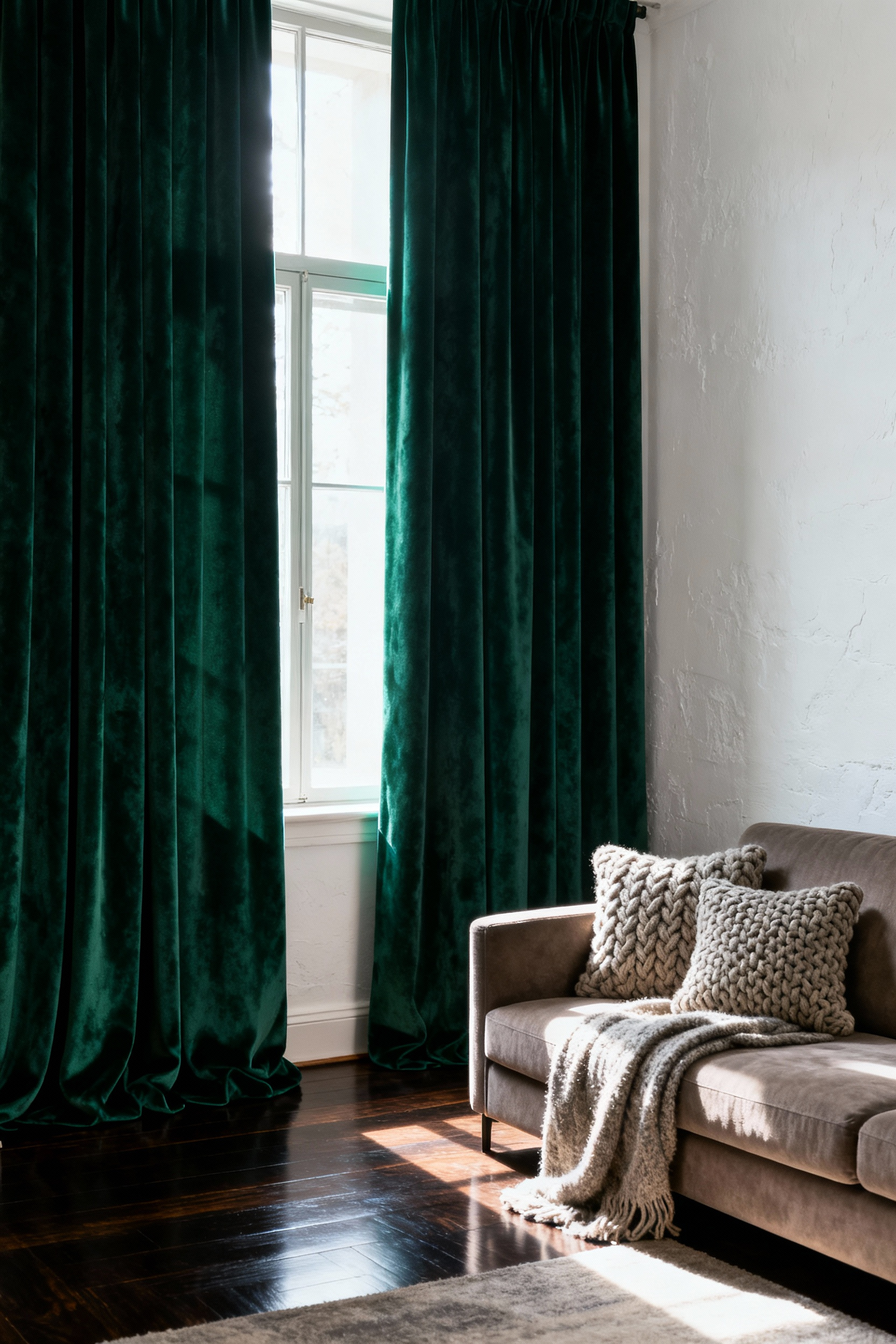
Proper installation enhances both the visual impact and the sound-dampening capabilities of the window treatments. Mount your curtain rod or track as close to the ceiling as possible to increase the vertical surface area available for absorption. This placement also draws the eye upward, creating the illusion of a taller room.
Ensure the drapes offer substantial fullness by selecting panels wider than the window itself; this maintains deep, thick pleats even when the curtains are closed. For a polished finish, measure the fabric to barely graze or “kiss” the floor, providing a clean line without messy pooling.
For the most adaptable setup, employ a layering technique. Install a dual system that places a heavy acoustic drape over a light, sheer fabric. This allows you to enjoy diffused natural light during the day while reserving the heavier layer for nighttime privacy and sound insulation. This flexible approach ensures you can manage light levels and acoustics simultaneously without compromising the room’s cozy, tailored aesthetic.
5. Furniture Arrangement: Pulling Pieces In for Intimate Conversation Circles
Floating your furniture away from the walls transforms the energy of a room instantly. Instead of pushing sofas and chairs to the perimeter, pull them inward to create a dedicated zone for connection. Arrange your seating in a U-shape, L-shape, or semicircle rather than a straight line facing a television.
This orientation ensures guests face one another, which naturally encourages eye contact and facilitates easy dialogue without distractions. To visually define this floating arrangement, anchor the grouping with an area rug. This ties distinct pieces together into a cohesive unit and grounds the space within the larger room.

Proper spacing is critical for comfortable interaction. Maintain a distance of 4 to 8 feet between main seating pieces to allow for conversation without the need to raise voices or lean in uncomfortably. Beyond 8 feet, the sense of intimacy dissipates.
Within this zone, incorporate flexible elements to adapt to different group sizes. Utilize lightweight pieces like accent chairs, ottomans, or poufs that move easily. These items can be tucked away for smaller, daily arrangements or pulled into the circle when accommodating more guests, ensuring the room remains functional for any occasion.
6. Textile Mastery: The ‘Rule of Three’ for Throw Pillows
Transforming a seating area begins with the “Rule of Three.” Arranging pillows in odd-numbered groupings, such as three or five, creates immediate visual interest and balance. Unlike symmetrical even pairings, which often appear rigid or staged, asymmetrical arrangements feel organic. This simple shift breaks the monotony of a standard layout and establishes the relaxed, lived-in aesthetic essential for a cozy atmosphere.
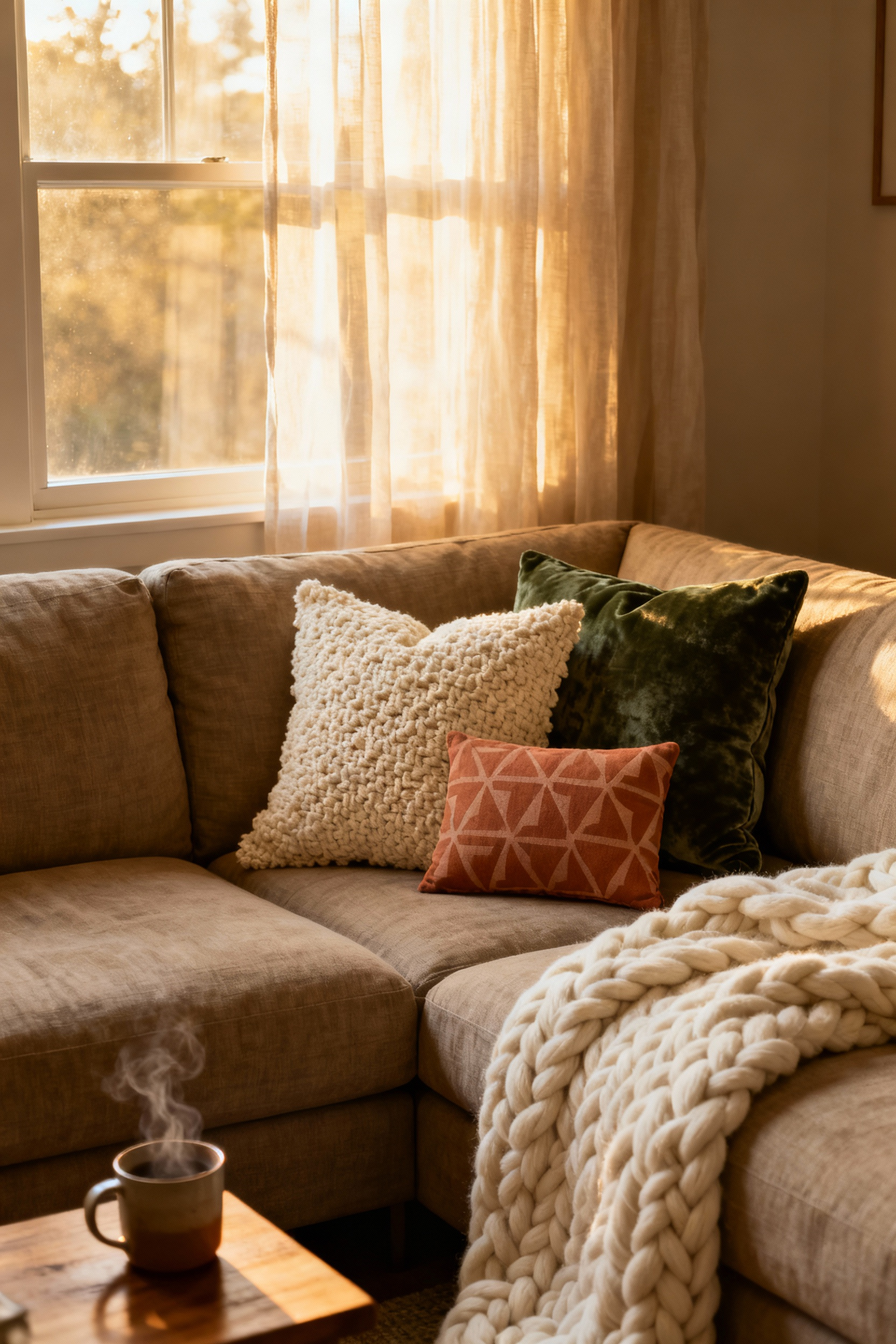
True textile mastery requires contrast to build depth. Select three pillows that feature distinct tactile textures: pair a smooth fabric, like velvet or leather, with a woven option, such as wool, and finish with a tactile accent like faux fur. Simultaneously, vary the scale of your patterns and shapes. A professional arrangement typically anchors the look with a large square featuring a dominant pattern, layers in a smaller square with a medium print, and concludes with a solid-colored rectangular lumbar pillow.
Unify this variety by establishing a cohesive three-color story drawn from existing elements, such as your rug or artwork. This ensures the pillows integrate seamlessly into the room’s design rather than cluttering it. To complete the look, drape a complementary throw blanket over the arm of the sofa. This addition introduces a fourth textural element and encourages physical comfort, making the space fully adaptable and inviting.
7. The Art of the Drape: Styling Chunky Knits for Casual Elegance
Chunky knit throws serve as powerful textural statement pieces in a living room, but their placement requires intention. To achieve casual elegance, avoid folding these blankets into perfect squares. Instead, loosely drape the knit over the corner of a sofa or let it spill slightly over the back of an armchair. This technique adds immediate dimension and makes the seating area look inviting yet effortlessly chic.
To prevent the look from feeling heavy, pair the voluminous texture of the knit with sleek surfaces. Placing a chunky throw against a leather sofa or next to a velvet pillow creates necessary tactile contrast. This breaks up visual monotony and establishes the blanket as a sophisticated counterpoint rather than a bulky addition.
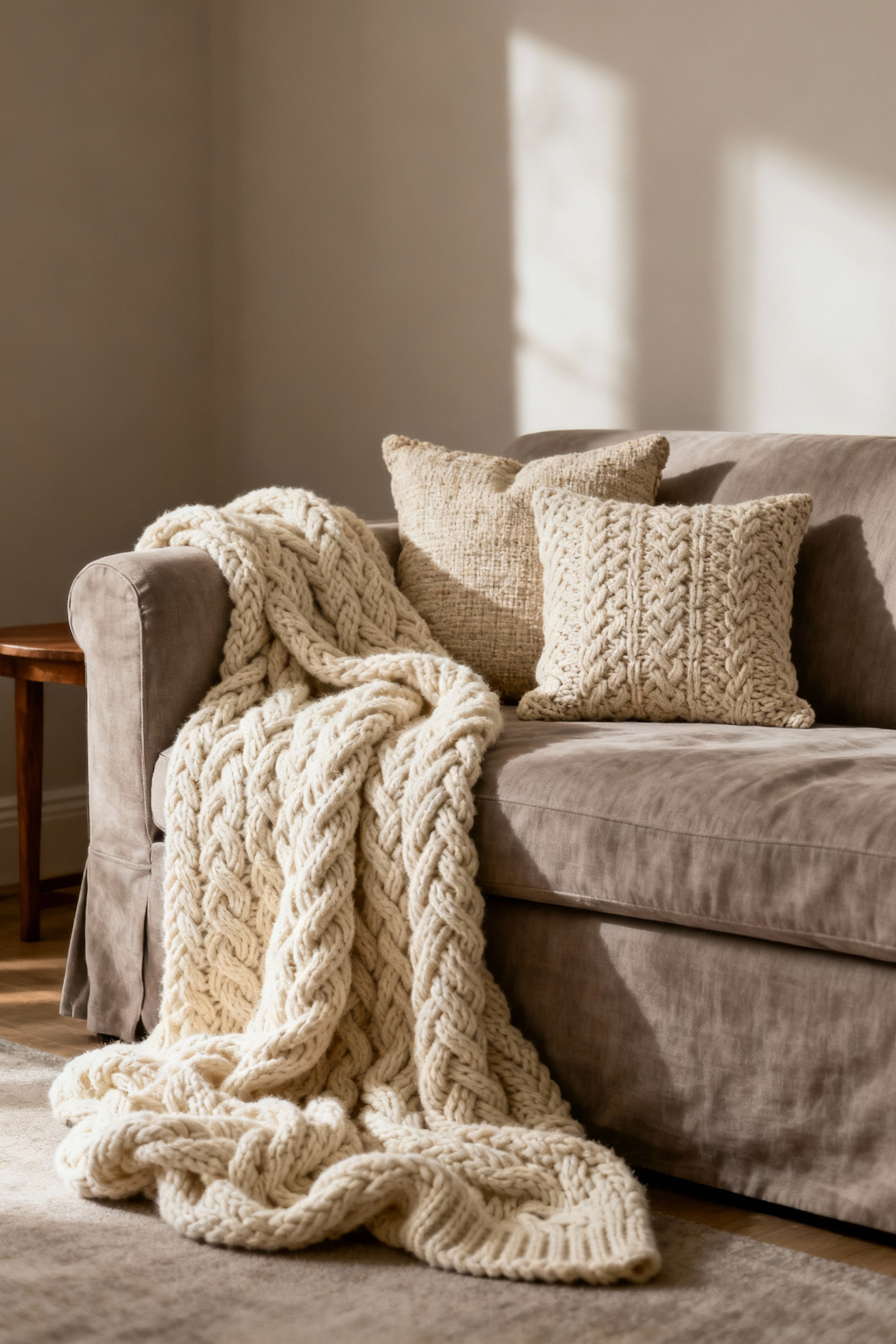
Color selection and storage strategies further refine this aesthetic. Opt for soft neutrals like cream, ivory, taupe, or warm grey to ensure the piece remains timeless. Alternatively, select a shade that echoes a subtle accent already present in the room to create a harmonious, put-together look.
When the blanket is not in use, manage its size through decorative storage. Roll or loosely fold the throw into a large, open-weave basket placed near a fireplace or side chair. This approach keeps the space free of clutter while transforming a functional item into a deliberate decor element.
8. Texture Contrast: Pairing Rough Woods with Soft Velvets
Texture plays a crucial role in establishing a cozy atmosphere, and few combinations offer as much impact as pairing rough, natural woods with soft, luxurious velvets. This specific juxtaposition adds immediate depth to a living space and serves as a core element of the “Modern Rustic” design aesthetic. The sleek, refined nature of velvet elevates rustic wood, preventing the space from appearing too informal. Conversely, the wood grounds the velvet, ensuring the room remains inviting rather than feeling overly formal or flashy.
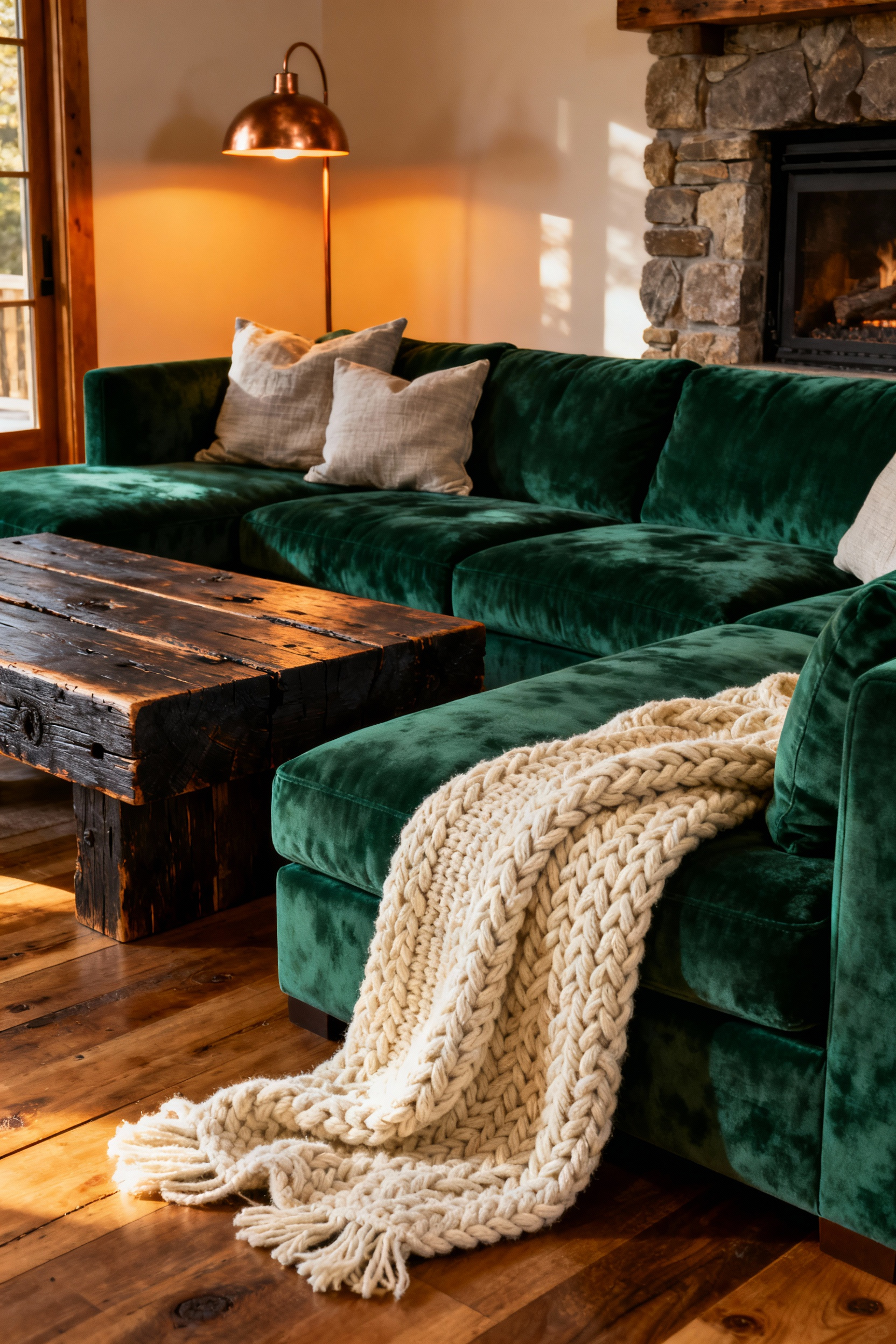
For maximum visual effect, position your anchor pieces directly next to each other. Place a plush velvet sofa or armchair facing a reclaimed or rough-sawn wooden coffee table. This arrangement creates a necessary balance; the wood provides grounding “visual weight,” while the velvet offers a soft welcome.
To further amplify the warmth, select velvet in rich jewel tones like emerald or sapphire, or deep neutrals like ochre. The fabric’s ability to catch the light creates a dimensional sheen that contrasts beautifully with the matte, earthy tones of the wood.
If purchasing new furniture is not an option, you can achieve this look through adaptable, low-commitment accessories. Use these smaller elements to introduce texture contrast:
- Soft Accents: Place velvet throw pillows on your existing linen or cotton sofa to introduce a layer of luxury.
- Rough Elements: Pair those textiles with a rough wood accent piece, such as a simple tree-stump side table.
- Decor Details: Incorporate natural wood picture frames on nearby surfaces to echo the rustic theme without overwhelming the space.
9. Warm Color Palettes: Transitioning from Stark Whites to Creamy Neutrals
The shift from stark white to creamy neutrals creates an inherently warmer and more inviting living room. To successfully make this transition, select paint and fabric colors with subtle yellow, red, or brown undertones, such as ivory and ecru. These warm-based hues replace the clinical feel of cool, blue-based whites and help balance the light in north-facing rooms.
Avoid a flat, monochromatic look by prioritizing layered tonal schemes. You can achieve depth by mixing creamy white walls with beige furniture, taupe throws, and soft greige accents, creating a rich and sophisticated backdrop.
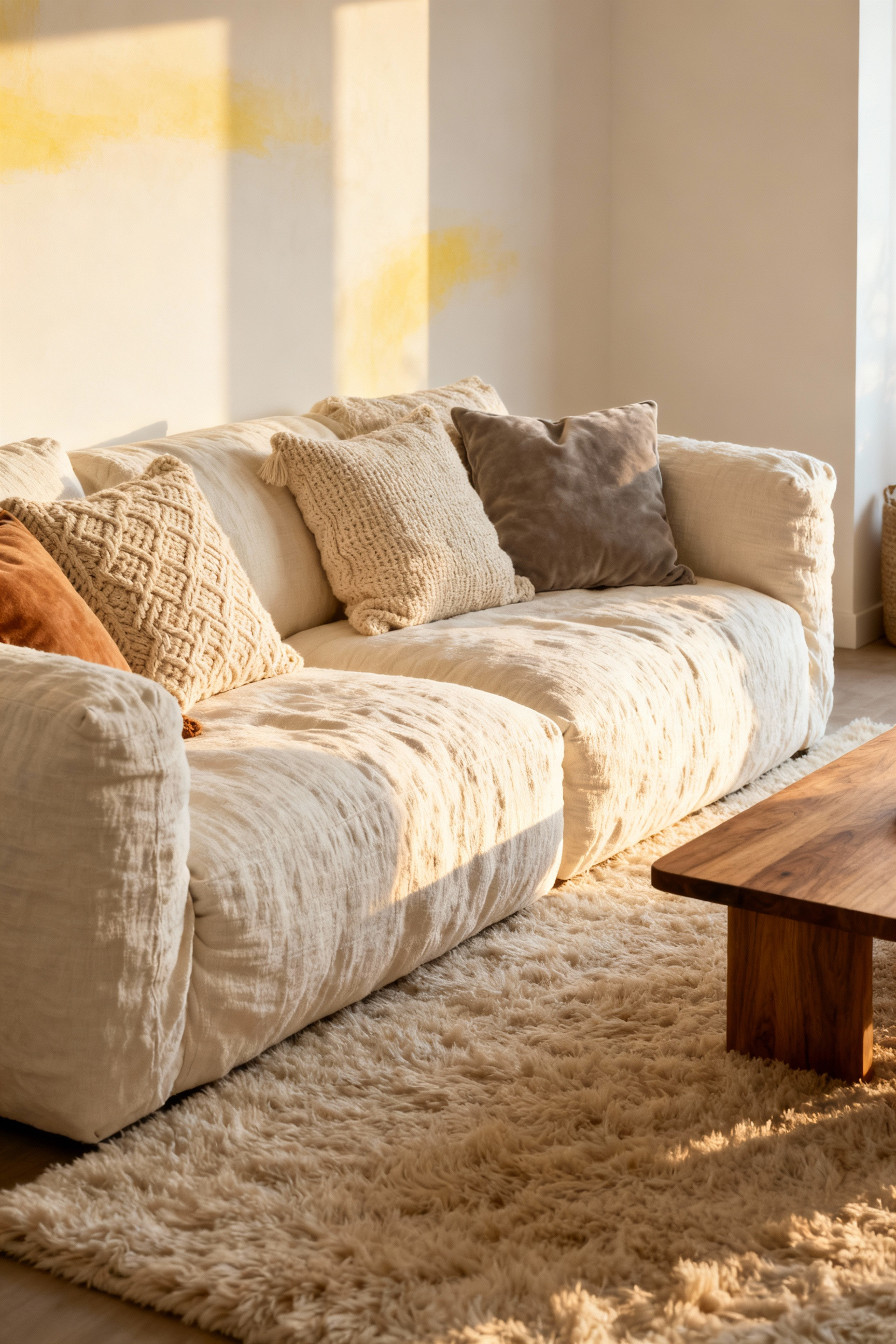
Texture acts as a vital component in adding interest to a cream-based palette. Incorporate natural, tactile materials to prevent the space from feeling bland. Consider a boucle or linen sofa paired with a chunky knit throw, a jute rug, or natural stone accents. These varying textures work best when illuminated by warm-toned lighting. Swap out harsh, stark bulbs for “soft white” options (typically 2700K–3000K) to enhance the softness of the creamy tones and ensure the room feels cozy rather than sterile.
To prevent the design from looking washed out, ground the space with dark accents. Strategic touches of contrast anchor the lighter elements and add definition. Introduce rich materials like walnut or mahogany woods, inky black metal hardware, or deep accent colors such as navy blue or dark amber through pillows and artwork. This method secures the visual weight of the room, ensuring the neutral palette remains elegant and intentional.
10. The Reading Nook: Carving Out a Sanctuary in Unused Corners
Transform wasted square footage into a dedicated retreat by targeting architectural quirks within your living room. Deep niches, under-stair areas, or simple empty corners often offer the best potential for a built-in bench or a small-profile armchair.
Clearly “carve out” this sanctuary from the rest of the open space to establish it as a distinct zone. Use a specific paint color, wallpaper, or a small area rug to visually define the boundary and signal a shift from social interaction to solitary relaxation.
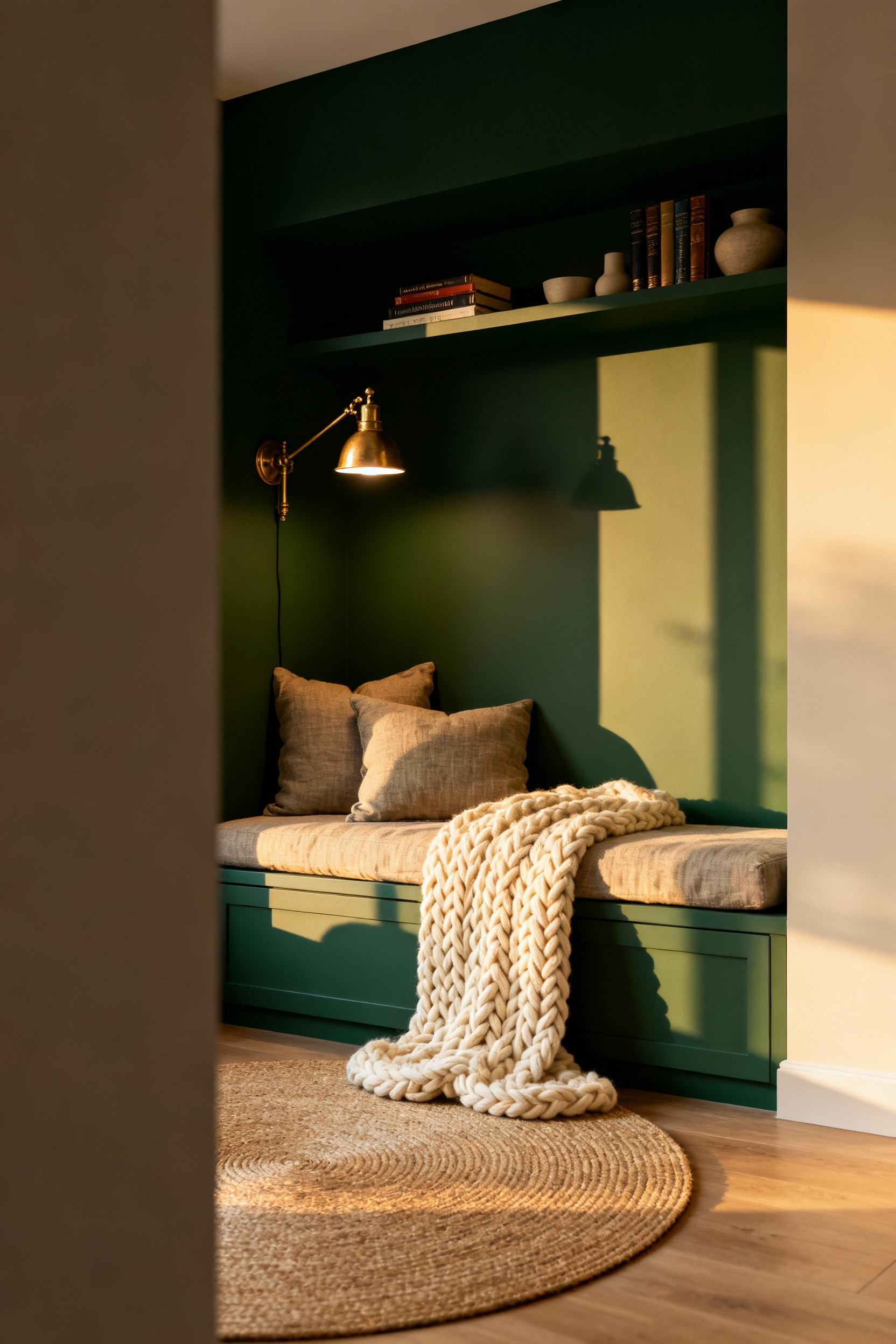
Maximize the “cocoon” feel through strategic layering of textures. Anchor the space with soft textiles, including plush throw blankets and pillows that offer necessary lumbar support. Lighting serves a dual purpose here; select adjustable floor lamps or wall sconces to cast focused light directly onto your reading material. Balance this with soft, ambient sources like string lights or a warm table lamp to maintain a cozy atmosphere without straining your eyes.
Integrate compact storage to keep the area functional and clutter-free. Position a small side table, plant stand, or stool within arm’s reach to hold essentials like reading glasses, a candle, or a warm drink. Utilize vertical shelving or internal bench storage for books to maximize floor space. This approach ensures the nook remains a practical, intimate escape that serves a specific function throughout the year.
11. Organic Elements: Introducing Dried Branches and Winter Greenery
Bringing nature indoors introduces raw textures and quiet beauty that ground a space during the colder months. To create a striking focal point, utilize sculptural branches to add dramatic height and form. Place tall, bare options like birch logs, curly willow, or wispy pine stems into large, textured floor vases.
Selecting the right vessel is crucial for this aesthetic; opt for containers made of stoneware, rustic wood, or woven baskets. These tactile materials enhance the cozy, grounded atmosphere and fill empty corners or fireplace hearths with organic elegance.

Layering is the key to achieving professional-level depth in your styling. Combine the rich colors of winter greenery, such as evergreen or eucalyptus sprigs, with neutral dried elements. Incorporating pampas grass, dried hydrangeas, or cotton stems creates a soft contrast against the sharper needles of fresh greenery. For smaller surfaces like coffee tables or mantels, arrange these clippings alongside pinecones and natural wooden elements. This approach results in low-maintenance, earthy vignettes that celebrate the season without relying on specific holiday motifs.
Lighting transforms these natural structures into mood-setting features. Weave tiny LED fairy lights through your tall arrangements of bare or frosted branches. The lights highlight the architectural shape of the wood and create a soft, magical glow. This simple addition provides instant warmth, making the room feel inviting and perfect for a cozy winter evening.
12. The Fireplace Focal Point: Styling Mantels for Maximum Warmth
The fireplace naturally commands attention in a living room, serving as the heart of the home’s design. To maximize this effect, start by placing a single, oversized anchor piece above the mantel. A large, warm-toned artwork or a tall mirror instantly establishes the focal point.
Mirrors are particularly effective as they reflect light, making the space feel brighter and more open. Once anchored, layer the ambiance with warm lighting elements. Incorporate brass or gold candlesticks, or wall sconces on either side, to create a soft, layered glow. This ensures the area remains inviting and enhances the room’s mood even when the fire is unlit.

To finish the look, introduce natural elements and intentional styling techniques. Bring in rustic textures through fresh or faux greenery, rough-hewn wood accents, or decorative logs stacked neatly in the firebox. These organic touches evoke a cabin-like sense of comfort.
When arranging these items, avoid clutter by applying the “rule of three” or grouping objects in odd numbers. Create visual interest by varying heights, such as placing stacked books next to a tall vase. This method builds visual depth, transforming a simple shelf into a curated, professional vignette.
13. Sentimental Styling: Curating Books and Artifacts that Tell a Story
True sentimental styling requires intentionality to ensure a warm, lived-in atmosphere rather than a cluttered one. Begin by treating your books as both structural tools and art. Stack some volumes horizontally to serve as risers for smaller objects, while placing others vertically. You can even display beautiful or meaningful covers facing forward to showcase your personality.
To organize these collections effectively, apply the “power of three.” Group odd numbers of items together on your coffee table or shelves and vary their heights. This technique, known as creating a vignette, creates visual interest and ensures the arrangement looks designed rather than accidental.

Balance the hard lines of shelves and books by layering in soft, tactile elements. Incorporate “woven” textures, such as trays or baskets, to group loose items and add warmth. Mix in heirloom artifacts that possess a clear history to avoid a generic, mass-produced look. Items like inherited ceramics, vintage editions, or handmade stitchwork bring authentic character to the space. This approach embraces the charm of the “Cluttercore” trend without the mess, ensuring the room feels deeply personal and grounded in history.
Extend this narrative to your vertical space with a gallery wall. Combine framed photos of meaningful moments with unique mementos, such as an antique letter or a framed family recipe. For a cohesive and classic appearance, consider printing personal photos in black-and-white or sepia tones. This method anchors the room and tells a visual story that is uniquely yours, turning your walls into a sophisticated timeline of your life.
14. Scentscaping: Using Seasonal Aromas to Trigger Relaxation
Scentscaping involves strategically using fragrance to partition your day and define the atmosphere of your home. In a living room designed for comfort, aroma acts as an invisible design element that sets the mood instantly.
To ground the space, embrace warm, gourmand, and woody base notes. Scents like vanilla, sandalwood, amber, and cedarwood evoke feelings of stability and nostalgia, making the room feel physically warmer and more inviting. By aligning your fragrance choices with nature’s rhythm, you enhance the seasonal experience; opt for spiced notes like clove and pine in the winter, while switching to fresh mint or soft florals in the spring to keep the relaxation area feeling crisp.
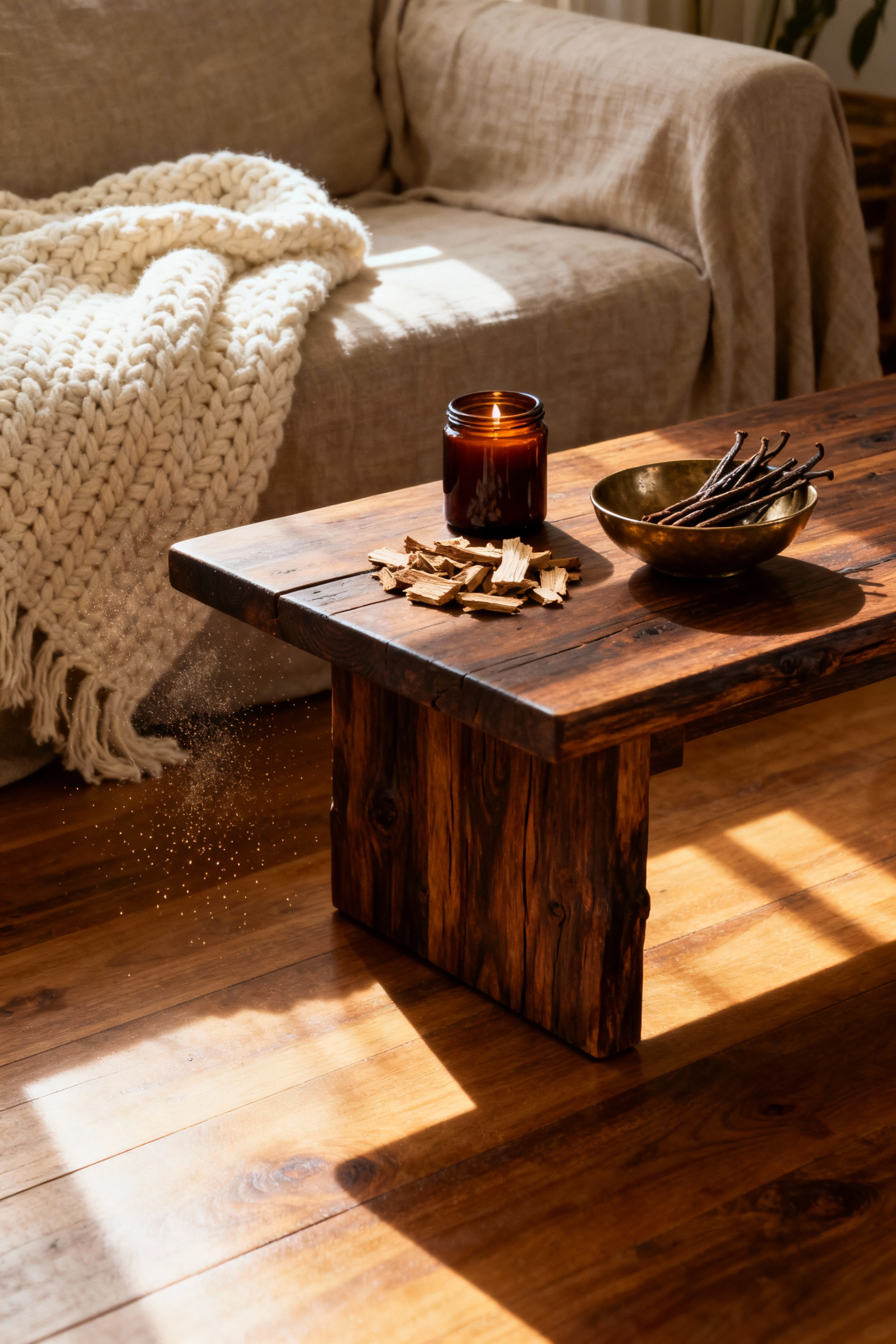
Beyond seasonal shifts, use scent to signal the specific transition from a busy day to a restful evening. Lighting a candle with calming notes of rose, lavender, or chamomile triggers a neurological response that tells the brain it is time to unwind. This practice turns your living room from a daytime hub into a dedicated evening sanctuary.
To ensure this sensory trigger remains effective, you must prevent “fragrance fatigue,” a condition where you become desensitized to a constant smell. The most effective way to maintain a cozy atmosphere without becoming nose-blind is to layer your fragrance tools:
- Reed Diffusers: Use these for a consistent, subtle base scent that lingers in the background throughout the day.
- Candles and Sprays: Introduce these in the evening to add a momentary, stronger layer of fragrance that specifically marks the start of your relaxation time.
15. Visual Warmth: Incorporating Brass and Gold Hardware Accents
Brass and gold hardware accents introduce a unique layer of visual warmth to a living room, offering an inherent richness that feels both luxurious and inviting. To achieve a cozy rather than ostentatious aesthetic, prioritize brushed, satin, or matte finishes over high-shine polished options. A softer finish diffuses light instead of creating harsh reflections, resulting in a subdued and refined glow that better suits a relaxed space.
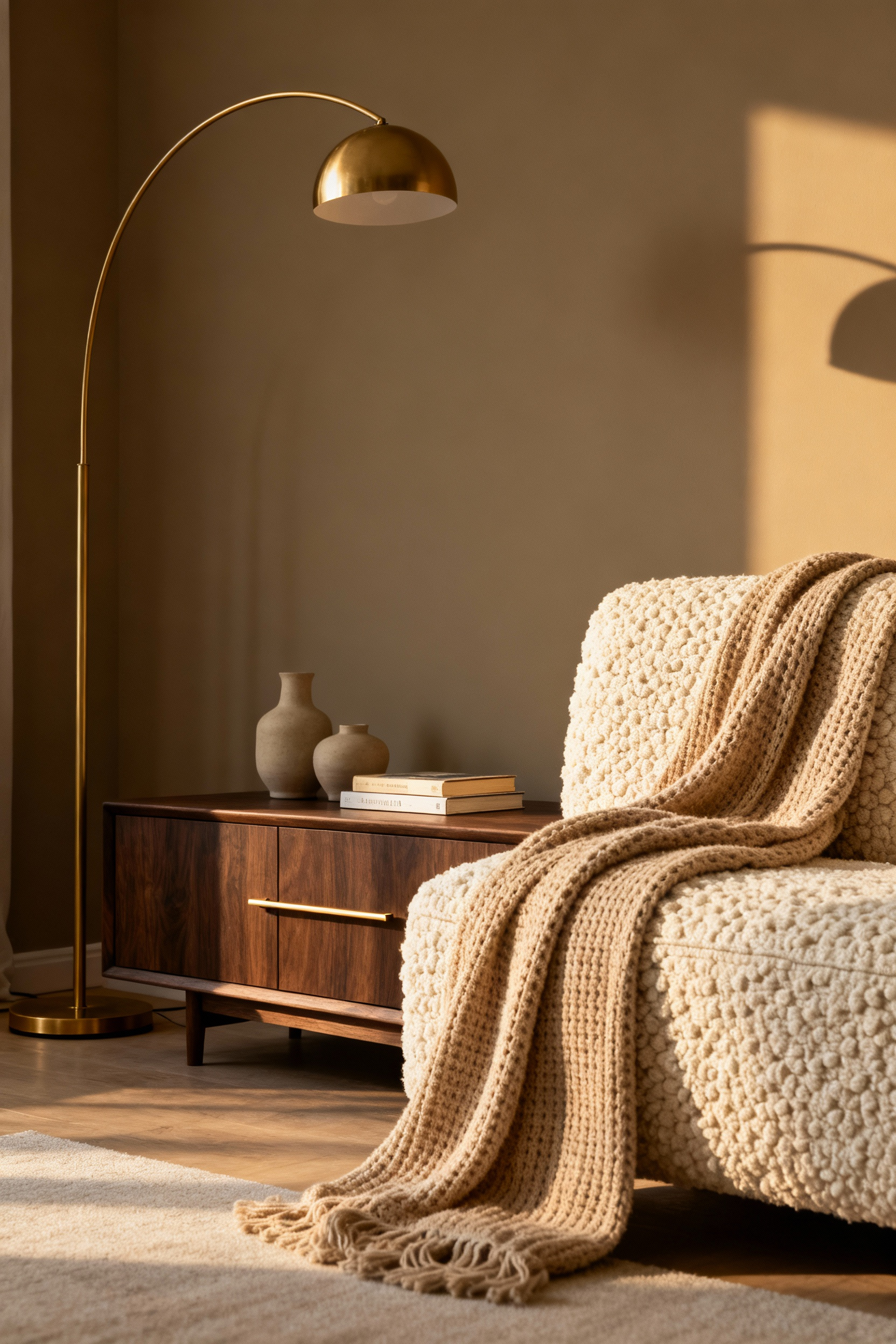
Strategic placement amplifies the impact of these metallic tones. Use lighting fixtures such as pendant lamps, floor lamp bases, or wall sconces as focal points. When the bulb illuminates the fixture, the light reflects off the metal to enhance its warmth and cast a flattering, ambient glow.
For a less permanent update, start with small, scattered accents. Distribute low-commitment items like brass photo frames, gold-toned mirror frames, or metal-accented coffee table trays across different surfaces to add subtle sparkle and visual interest without overwhelming the room.
To maximize the effect of brass and gold, pair these metals with rich textures and deep colors. The golden hues create a striking contrast against moody palettes like navy, emerald green, or deep charcoal. Incorporating natural materials such as warm walnut woods, velvet upholstery, or deep-toned leather further enhances the metal’s character. These complementary elements work together to create a sense of depth and establish a sophisticated, layered environment.
16. Seasonal Agility: Creating a Base Layer That Adapts from Fall to Winter
Seasonal agility allows you to maintain a stylish, comfortable home without reinventing the space every few months. The most effective strategy involves establishing a permanent neutral base for your largest, most expensive items.
Keep your sofa, primary curtains, and main area rugs in season-proof colors like cream, soft gray, or ivory. This flexible foundation allows smaller, temporary accent layers to handle the seasonal work, eliminating the need for major overhauls as the weather cools.

Once your neutral backdrop is set, focus on upgrading the floor layer to combat lower temperatures. If you have hardwood or tile, swap a lighter rug for one with a deep, thick pile. Alternatively, strategically layer a high-texture accent rug, such as faux fur or sheepskin, on top of your existing carpet. This technique provides literal warmth underfoot and adds the visual weight necessary for winter coziness.
Complement this by replacing lightweight fall fabrics like linen or cotton with “pet-able” winter textiles. Drape chunky knits, velvet, and mohair over sofas and chairs to create an immediate cocooning effect.
Finally, use your neutral canvas to pivot your accent colors from the exterior focus of fall to the interior focus of winter. Transition away from warm, earthy tones like rust, burnt orange, and golden yellow. Instead, introduce introspective shades that evoke a sense of calm and enclosure, such as navy, deep forest green, charcoal, and rich jewel tones like plum or emerald. By simply shifting these top-layer accents against your consistent base, you achieve a complete atmospheric transformation with minimal effort.
Conclusion: Designing for the Rhythm of Rest
True comfort requires more than aesthetic choices; it demands a strategic approach to how a room functions as the day progresses. By synchronizing layered lighting with tactile sensory anchors, you transform your home from a static backdrop into a responsive environment that supports your body’s natural cycle.
When you weave biophilic elements with the visual rhythm of repetition, you create a cocoon that feels both grounded and secure. This holistic approach ensures your space does not merely look inviting, but actively signals your nervous system to slow down, settle, and recharge.
As modern lifestyles intensify, the home must evolve into a sanctuary of intentional pause. Prioritizing this rhythm of rest ensures your living environment adapts to your physical well-being, offering deep tranquility regardless of the season. Begin your transformation by auditing your evening lighting scheme this week. Replace harsh overhead sources with warm, dimmable table lamps to immediately establish a visual cue for relaxation, setting the stage for a fully realized cozy living room that truly restores you.
Frequently Asked Questions
What is the optimal color temperature for creating a cozy living room?
The gold standard for achieving a cozy and restorative atmosphere is 2700K (Kelvin), often labeled “Soft White.” This temperature mimics the warm, intimate glow of traditional incandescent bulbs or firelight, softening shadows and eliminating the harsh, clinical feel associated with cooler blue-toned lighting (4000K+).
How do luxury designers make a living room feel cozy without looking cluttered?
Designers achieve a cozy, curated look by focusing on intentional layering rather than excessive objects. They utilize organizational strategies like the “Rule of Three” when styling vignettes and maximize the impact of tactile textures (like velvet and wool). The key is managing visual weight: keeping the most substantial items (sofas, rugs) neutral, and reserving personal items (books, artifacts) for styled, odd-numbered groupings.
Should I avoid overhead lighting entirely when designing a cozy living room?
It is highly recommended to minimize or completely eliminate reliance on singular overhead fixtures. A truly cozy space adheres to the three-layer lighting rule, utilizing floor lamps (ambient), table lamps (task), and wall sconces (accent). This layering creates necessary architectural depth and “pools of warmth” that prevent the room from feeling flat or sterile, which standard overhead lights often do.






